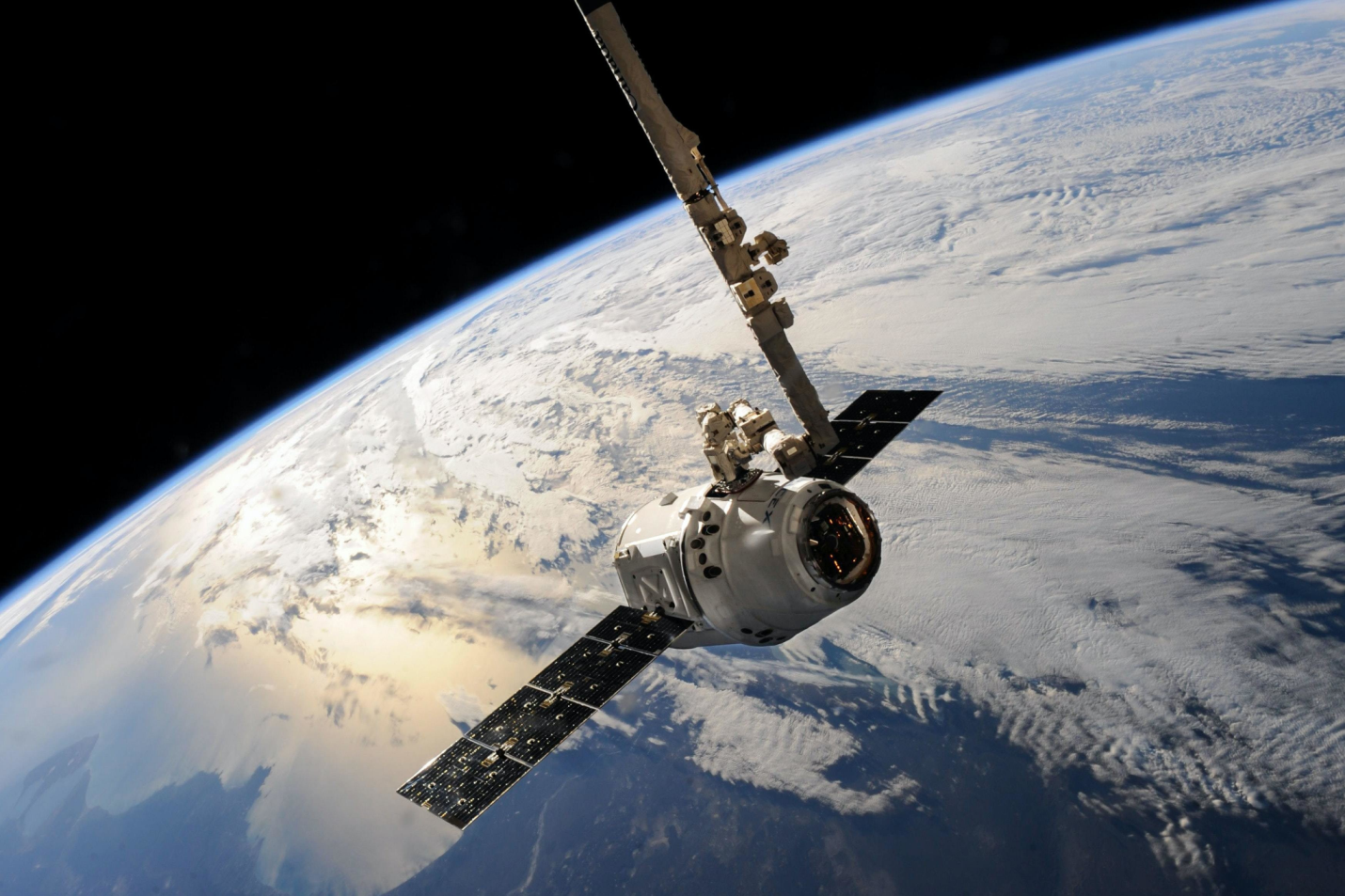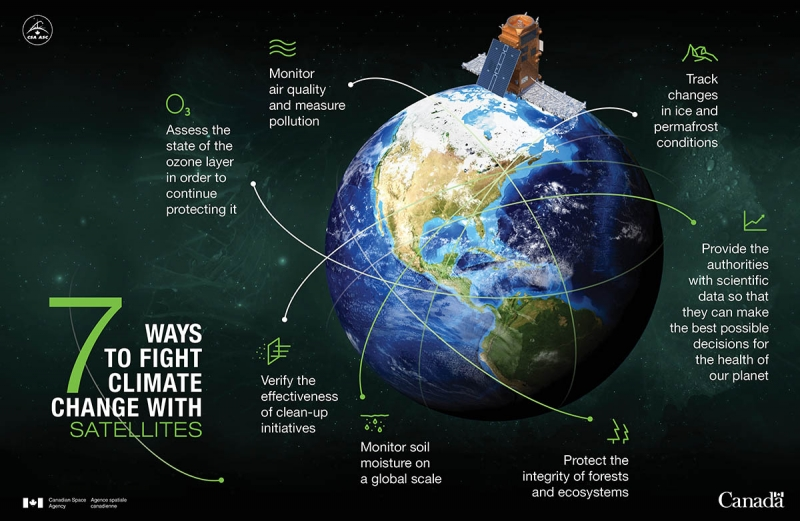





Copyright infringement not intended
Picture Courtesy: https://www.weforum.org/agenda/2022/07/environmental-impact-space-debris-how-to-solve-it/
Context: SpaceX, under Elon Musk's leadership, intends to dispose of 100 Starlink satellites in the next six months, employing de-orbiting to prevent potential threats due to a design flaw.
Key Highlights
Concerns Raised by Atmospheric Scientists
Satellite Debris in Low Earth Orbit
Satellite Disposal Methods
Environmental Impact on Earth's Atmosphere
Uncertainty and Need for Research

Impact of Satellites on the Environment
|
Impact Area |
Explanation |
Negative Impacts |
Mitigation Strategies |
|
Space Debris |
Defunct satellites, rocket stages, and fragments create collision risks and hinder future space activity. |
Collision risk with operational satellites. Orbital pollution restricts future space exploration. |
Active Debris Removal (ADR): Develop technologies to capture and de-orbit debris. Design for Demise: Build satellites to burn up or be directed to disposal orbits at end-of-life. International Regulations: Establish standards for responsible satellite design and disposal. |
|
Light Pollution |
Bright satellites in low orbit interfere with astronomical observations and potentially affect nocturnal ecosystems. |
Disrupts astronomical observations. Potential negative impact on light-sensitive ecosystems. |
Responsible Design: Minimize satellite reflectivity and carefully choose deployment orbits. Collaboration: Engage with astronomers to find solutions and mitigate impacts. |
|
Electromagnetic Radiation |
Satellite transmissions can interfere with Earth-based communication systems. |
Radiofrequency interference with radio astronomy and terrestrial communication. |
Frequency Coordination: Allocate and manage satellite frequencies to minimize interference. Development of Interference-resistant Technologies: Advance technologies less susceptible to interference. |
|
Resource Intensiveness |
Manufacturing and launching satellites consume significant resources and contribute to environmental burdens. |
Resource extraction and processing. Energy consumption during production and launch. - Waste generation. |
Sustainable Material Sourcing: Utilize recycled materials and eco-friendly alternatives. Energy-efficient Production: Implement energy-saving practices throughout the production chain. Waste Reduction and Recycling: Minimize waste generation and promote responsible waste disposal. |
|
Energy Consumption |
Satellites require continuous energy for operation, contributing to overall energy usage. |
Increased global energy consumption. |
Energy-efficient Satellite Design: Develop satellites with lower energy requirements. Renewable Energy Integration: Explore options for powering satellites through renewable sources like solar energy. |
|
Climate Change Contribution |
Satellites activities, including manufacturing, launch, and operation, contribute to greenhouse gas emissions. |
Emissions from satellite production, launch, and energy use. |
Cleaner Propulsion Systems: Develop and use less polluting rocket fuels and engines. Reusable Launch Vehicles: Reduce reliance on disposable rockets and the associated emissions. Carbon Offsetting: Consider carbon offset initiatives to compensate for emissions. |
|
Chemical Propellant Pollution |
Rocket launches release chemical propellants, potentially impacting air and water quality. |
Air and water pollution depends on the specific propellant used. Potential health and ecological risks. |
Cleaner Propellant Development: Research and develop environmentally friendly propellants with minimal environmental impact. Launch Site Selection: Conduct launches at locations with minimal environmental impact. |
|
Frequency Spectrum Crowding |
The increasing number of satellites can lead to competition for limited frequency bands, impacting other communication systems. |
Reduced efficiency and increased interference due to spectrum congestion. |
Spectrum Management: Implement efficient and dynamic spectrum allocation techniques. Technological Advancements: Develop communication systems less susceptible to interference. |
|
Erosion of Space for Astronomy |
Satellite constellations can obstruct the view of celestial objects, impacting astronomical observations. |
Disruption of ground-based and space-based astronomical research. |
Responsible Constellation Design: Design constellations with minimal impact on astronomical observations and collaborate with astronomers. Data Sharing and Transparency: Share satellite data and operational plans with astronomical communities. |
|
Military Satellite Activities |
Military satellites raise concerns about global security and potential conflicts in space. |
Geopolitical and security implications. Potential for conflict in space with broader repercussions. |
International Cooperation: Promote international dialogue and establish treaties for peaceful use of space. Transparency and Confidence-building Measures: Build trust and transparency among countries involved in space activities. |
|
Global Navigation Satellite Systems (GNSS) |
GNSS like GPS improve navigation but can lead to a decline in traditional navigation skills. |
Over Reliance on GNSS and potential loss of traditional navigation skills. |
Education and Training: Promote awareness of traditional navigation skills alongside GNSS reliance. Development of Backup Systems: Develop and maintain backup navigation systems independent of GNSS. |
|
Technological Advancements |
Satellites contribute to technological advancements, but raise societal concerns. |
Issues related to privacy, data security, and reliance on satellite technology. |
Ethical and Responsible Development: Implement ethical considerations and responsible practices in |
Conclusion
Must Read Articles:
SATELLITE-BASED GIGABIT INTERNET: https://www.iasgyan.in/daily-current-affairs/satellite-based-gigabit-internet
|
PRACTICE QUESTION Q. The increasing number of satellites in orbit raises concerns about potential collisions and the creation of space debris. Evaluate the effectiveness of current international regulations and initiatives aimed at mitigating space debris. What are the challenges and limitations of these approaches, and what potential improvements or alternative strategies could be considered? |







© 2025 iasgyan. All right reserved